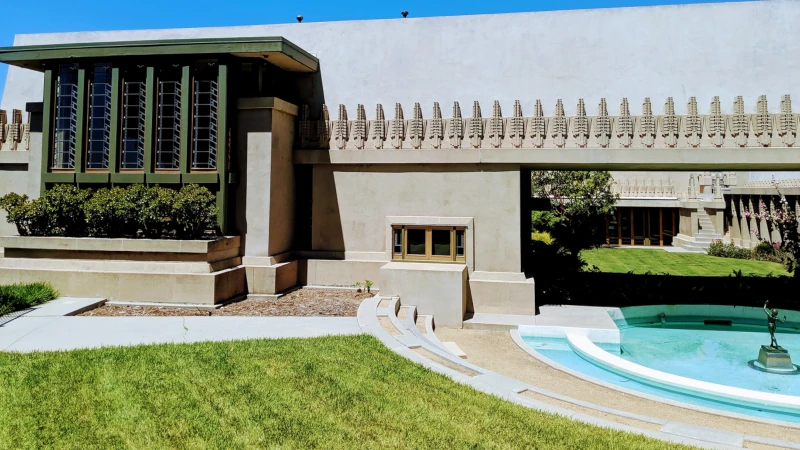For any architectural fans of Frank Lloyd Wright living in Marin County, a tour of the Marin County Civic Center is a must. The 90-minute docent-led walking tour provides the complicated, and some suggest scandalous, history that finally led up to the completion of his last building. It is the only one he created for a government entity.
Begun in 1957 by Wright, the project had several stages, and construction was completed after his death in 1959. Two of his acolytes, Taliesin Senior Architect Wesley Peters and San Francisco Bay Area Taliesin Architect Aaron Green, completed buildings through 1976.
Green was consulted on the construction of the “new” jail that he suggested should be constructed underground. Due to very limited space, this meant it would not spoil Wright’s concept of the Administration building melding into the surrounding hills. Completed in 1994, the 222 cells, with 363 beds, built into one of those hills connects to the Hall of Justice through an underground link.
The tour highlights many of the unusual, modernistic aspects of Wright’s design and even features some of the original Wright-designed furniture, crafted by inmates from San Quentin’s wood shop.
But you don’t have to stop there.
A January 2024 article in Architectural Digest featured 29 homes nationwide, which Wright fans can visit. Four of the homes open for tours are located in California.
Bakersfield hosts the George and Millie Ablin House commissioned, with plans drawn up in 1958, only one year before Wright’s death. The home is another Wright wonder completed in 1961. High on a hill, near the edge of the Mojave Desert, with mountains in the distance and kept in near pristine condition, the home remained in the Ablin family until 2009. The structure offers glimpses into how much attention Wright gave to biophilic design (connecting occupants more closely to nature), and the intrinsic details carried through his work right down to the furniture. David Coffey, the home’s current owner, leads the tours and plans to turn the home over to a nonprofit status.
Bradbury features the Wilbur Pearce House, an example of Wright’s solar hemicycle design, which arches inward to capture the maximum power of the sun. Unlike the George and Millie Ablin House, this one was in need of extensive restoration work, but photos reveal the stunning beauty so worth recapturing. It is also a great example of Wright’s cinder-block homes. Konrad Pearce, grandson of the original owners, is the current owner who is offering tours of this unusual home as a way of fundraising for the needed repairs.
On the Stanford University Campus, you will find the Hanna House. Originally designed in 1936 for a Stanford professor, Paul Hanna, and his wife, Jean, this beautiful red brick home is open twice each year for tours. According to their website, this collaboration between Wright and Hanna allowed Wright to branch out with a new concept to create “a house based on hexagonal geometry, with no right angles in the floor plan. This radical experimentation allowed Wright to explore open spatial planning. Hanna House was a turning point in his career, leading to ideas later evidenced in the Guggenheim Museum in New York.”
Lastly, in Los Angeles you can visit the Hollyhock House, Wright’s first California commission in 1919. This magnificent home sits on Olive Hill in Los Angeles. Wright’s client, Aline Barnsdall, the irreverent oil heiress and arts patron, made her likes and dislikes known to Wright, proving to be a forceful match for his own strong will and opinions. The creation appeared to be a marriage between his popular Prairie style and the more textile block designs evident in his creations throughout the next decade. The home was renovated recently, and the tour is well worth the cost of admission.
It seems fitting that the arc of his work in California that is available to the public through tours covers both Frank Lloyd Wright’s first California commission, the Hollyhock House and his last, the Marin County Civic Center. Don’t miss a chance to step into the world of this iconic architect.


